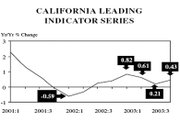Sluggish Economy Predicted Until End of the Year
California’s economy will remain lackluster through September and will pick up only slightly toward the end of the year, a recent Chapman University study shows.
The “California Leading Economic Indicator Series,” published quarterly by the university, demonstrates that the state economy declined during the second quarter and predicts that it will decline again during the third quarter and then pick up slightly during the latter part of the year.
“The message we are giving now is that at least things are not going to get worse than they are now,” said Esmael Adibi, director of the A. Gary Anderson Center for Economic Research at Chapman University in Orange, Calif.
The indicator series comprises several variables that paint a picture of future California economic activity. Those variables include the year-to-year change in the state’s gross domestic product, the state’s construction activity, changes in the Standard & Poor’s 500 Index and the state’s real export levels.
When times were booming at the beginning of 1998, the series ranked the economy at 2.7.
During the first quarter of 2002, the economy dwindled into negative territory with a rank of -0.59.
It has improved slightly. For the third quarter of 2003, the series ranked the economy at 0.21. Chapman expects it to inch up to 0.43 during the fourth quarter of this year.
“To show improvement in jobs, we need at least a 1,” Adibi said.
Three of the four components of the indicator series have improved since their recessionary levels in 2001. The year-over-year percentage change in real GDP is positive and growing. Residential construction is fueling the state’s overall construction spending. And the year-toyear percentage change in the S&P 500, while still negative, is not as much of a drag on the economy as it has been in the past.
The only variable that is truly pulling down the indicator series is real exports. California’s economy depends significantly on international trade. But the state’s trading partners are having problems with their own economies.
“We sell quite a bit to Mexico and Japan and Korea,” Adibi said. “All these economies are in recession or are showing signs of slow recovery. As our economy starts doing better, their economies will do better too.” —Deborah Belgum






















